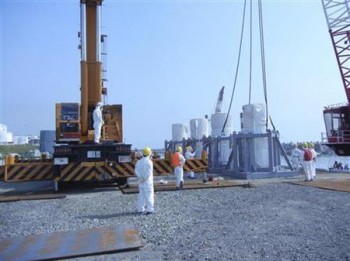You are here
by Yoko Kubota - Tokyo - Reuters - August 25, 2011

(Reuters) - Nearly six months after the world's worst nuclear crisis in 25 years at the Fukushima nuclear plant, Japan faces the task of cleaning up a sprawling area of radioactivity that could cost tens of billions of dollars, and thousands may not be able to return home for years, if ever.
Fuel core meltdowns at the facility in March, triggered by a huge earthquake and tsunami, released radioactive material into the air which mixed with rain and snow and covered dozens of towns as well as farmland and woods, mainly along the northeast coast of Honshu.
Tokyo has been slow to provide a plan for rehabilitation, leading some residents near the plant exposed to high levels of radioactive caesium in homes and food, have started their own cleanup instead of waiting for the government to act.
"I was worried about the radiation exposure impact on children and felt that I had to do something to reduce the radiation levels," said Hideaki Takita, a 37-year-old resident of Koriyama city, about 60 km west of the plant, who has been cleaning houses.
Takita and other volunteers use their weekends to scrape off layers of dirt in yards, wash walls and windows and bury or store the radioactive waste in the corners of properties in an effort to reduce radiation levels in the air.
"We are trying to bring the levels down for families who want to but can't evacuate, since they might feel slightly better," he said.
The government is set to announce cleanup guidelines this week that will include goals on cutting the radiation air dose rate in residential areas by half in two years, media reports said.
DAUNTING TASK
Still, the tasks Japan faces are daunting.
The accident at the Fukushima plant, about 240 km (150 miles) northeast of Tokyo, is likely to have released about 15 percent of the radiation that went into the air in the 1986 Chernobyl accident, Japan's Nuclear and Industrial Safety Agency said.
But that is still more than seven times the amount of radiation produced by Three Mile Island accident in the United States in 1979, and includes caesium 137, which has a half life of 30 years.
"The technology for decommissioning and cleaning up plants has been studied for a while, but we hardly have any experience in decontaminating materials that were released into the environment," said Tetsuo Iguchi, a Nagoya University professor.
"Fukushima is mountainous and such large-scale and highly concentrated contamination has not taken place on earth before in an area like this. How things will go is unpredictable."
The area in need of cleanup could be 1,000 to 4,000 square km, about 0.3 to 1 percent of Japan's total land area, and cost several trillion to more than 10 trillion yen (80 billion pounds), double what it took to build six nuclear reactors at Fukushima Daiichi plant, some experts say.
The government has banned people from entering an area in a 20 km radius surrounding the crippled plant and some 80,000 people have evacuated. Residents are calling on Tokyo Electric Power Co, the plant operator, to clean up the area, but the firm is still struggling to bring the reactors under control.
Another major headache is where to store the radioactive waste like dirt and water generated from cleanup work.
Currently, as with Takita's efforts, the waste is stored within the property where the cleanup took place. Some schools have a heap of radioactive dirt in the corner of their playgrounds, covered with plastic sheets, and residents bury sacks of contaminated waste in their yards.
"The issue of disposal zones is the most important for decontamination and unless plans are made, it won't move forward," said Kunihiro Yamada, a professor at Kyoto Seika University who does cleanup work in Fukushima city.
The amount of radioactive waste from decontamination is likely to be tens of millions of tonnes and the government in the long run plans to build an underground disposal facility to store this, though when and where is unclear.
COMPARISONS TO CHERNOBYL
Experts don't agree on the health impacts from radiation exposure. For Chernobyl, experts have not made reliable assessments on how many fatal cancer cases were caused by radiation exposure, the U.N. atomic watchdog said, though those exposed as children saw a substantial increase in thyroid cancer.
Unlike in Chernobyl, where the then-Soviet Union moved residents elsewhere, Japan, with limited land space and a different political system, should try to decontaminate to let residents return, experts said.
"We know we need to do this. The rest is down to people's spirits and how much money and personnel the national and local governments can provide," Iguchi of Nagoya University said, adding some 10,000 workers may be needed to clean up daily to finish the task in the next few years.
"Unless someone takes charge and continues to responsibly take the lead, efforts will stumble."
(Additional reporting by Yuko Takeo; Editing by Ed Lane)
http://uk.reuters.com/article/2011/08/25/uk-japan-nuclear-decontamination-idUKTRE77O3M520110825



Recent Comments